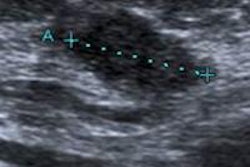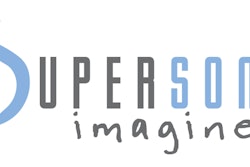Both strain elastography (SE) and shear-wave elastography (SWE) can combine well with B-mode ultrasound to improve differentiation of malignant and benign breast lesions, South Korean researchers recently reported in Ultrasound in Medicine and Biology.
In a study of 79 breast lesions, both elastography techniques yielded a significant increase in performance over B-mode alone, particularly in assessing BI-RADS category 4A lesions. No significant differences were found between SE and SWE.
"[The] addition of SE or SWE improved the diagnostic performance of B-mode [ultrasound], potentially reducing unnecessary biopsies," wrote a research team led by Dr. Ji Hyun Youk of Yonsei University College of Medicine in Seoul.
A number of studies have reported the value of breast elastography and its potential for decreasing the number of unnecessary biopsies; however, the one study that compared the performance of SE and SWE (American Journal of Roentgenology, August 2013, Vol. 201:2, pp. W347-W356) did not examine the clinical practice of a subjective assessment by radiologists following the combined reading of B-mode and elastography studies, according to the Yonsei researchers.
Quantitative mean elasticity for SWE and the qualitative strain score for SE also were not evaluated in the study, they wrote (Ultrasound Med Biol, October 2014, Vol. 40:10, pp. 2336-2344).
"Furthermore, the subcategories of category 4 (4A, 4B, and 4C) were not considered, even though they are useful in stratifying the likelihood of malignancy within the broad range of 2% to 95% among the large heterogeneous group of category 4 lesions and for communicating the level of suspicion to referring physicians and patients," the authors wrote.
Quantitative, qualitative assessments
As a result, the team sought to compare the diagnostic performance of both methods based on BI-RADS classification (including category 4 subcategories) for differentiating benign and malignant lesions using quantitative and qualitative assessments.
The study enrolled 86 consecutive women who had been scheduled to receive ultrasound-guided core-needle biopsy or surgical excision for breast lesions between September 2012 and October 2012. Eight women were excluded because pathology results were not available or elasticity values were not measured, leaving a final group of 78 women with 79 breast lesions.
One of five radiologists performed B-mode ultrasound and then shear-wave elastography on each patient using an Aixplorer ultrasound system (SuperSonic Imagine). Next, the patients received strain elastography from the same radiologist using a Hi Vision Ascendus ultrasound scanner (Hitachi Aloka Medical) with a 5- to 13-MHz linear-array transducer. After the imaging was completed and quantitative values were calculated, ultrasound-guided core-needle biopsy was performed using a freehand technique with the Aixplorer system.
Blinded to the clinical, mammographic, and histopathologic findings, two radiologists -- who had six and 15 years of breast ultrasound experience, respectively, and one year of breast ultrasound elastography experience -- independently reviewed each ultrasound image in reading sessions spaced with a two-week interval. The radiologists did not receive any elastography quantitative information for lesions.
After providing a BI-RADS final assessment category for each lesion on B-mode ultrasound, the radiologist reviewed a representative SWE color overlay image and recorded a qualitative six-point visual color score of maximum elasticity in the mass and surrounding parenchyma (Ecol), as well as a score for homogeneity of elasticity within the lesion and surrounding tissue (Ehomo).
When later reviewing a representative static SE image, the radiologist assigned a strain score on a scale of 1 to 5:
- Even strain over the whole lesion
- Even strain over most of the lesion, with some strain-free area
- Strain only at the periphery of the lesion, not in the center
- No strain over the whole lesion
- No strain over the whole lesion and in the surrounding area
Category 4A downgrades
For lesions that had initially been classified as category 4A on B-mode ultrasound, readers were asked to consider downgrading them to category 3 based on the elastography qualitative color map findings. Lesions in BI-RADS categories 3, 4B, 4C, or 5 were not allowed to be changed, according to the authors.
The researchers then compared the mean SWE elasticity values (Ecol and Ehomo) and the SE strain ratios for benign and malignant lesions, as well as the proportion of interobserver agreement. Diagnostic performance was determined by calculating the area under the receiver operator characteristics curve (AUC). Of the 79 lesions, 21 were malignant and 58 were benign on core biopsy or surgery.
While the mean SWE elasticity values had substantial interobserver agreement (κ = 0.75 for Ecol and κ = 0.72 for Ehomo), the SE strain score had moderate interobserver agreement (κ = 0.56). However, the combinations of B-mode and SWE and B-mode and SE both demonstrated substantial interobserver agreement (κ = 0.76 and κ = 0.79, respectively).
| Diagnostic performance for characterizing breast lesions | |
| Technique | Accuracy (AUC) |
| B-mode | 0.970 |
| B-mode + SE | 0.982 |
| B-mode + SWE | 0.987 |
The increases in performance were statistically significant for both strain elastography and shear-weave elastography (p < 0.05). The differences between SE and SWE were not significant, however. The value of the elastography methods was particularly evident in evaluating lesions classified as BI-RADS category 4A.
The researchers found that 38% and 56% of benign BI-RADS category 4A lesions with a low suspicion of cancer were downgraded without false-negative results using SE and SWE, respectively.
"The positive predictive value of category 4A increased from 5.3% for B-mode US alone to 11.1% and 8.2% for combined sets of SWE and SE, respectively," the authors wrote.
The improved performance in the category 4A lesions was realized via subjective decisions from the radiologists rather than using objective guidelines as a cutoff, the team noted.
"Regarding the application of elastography combined with B-mode US for downgrading category 4A lesions, the reviewers' subjective decision, rather than objective guidelines such as a cutoff, improved the diagnostic performance of breast US and potentially reduced unnecessary biopsies without the occurrence of false-negative results," they wrote.
Additional research with a larger patient population should be performed to assess the clinical implication of downgrading BI-RADS category 4A lesions or reducing unnecessary biopsies, the authors concluded.




















